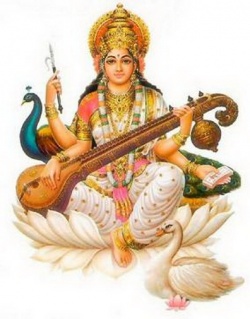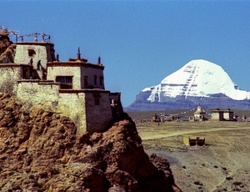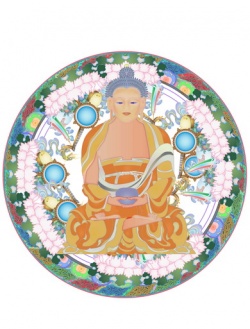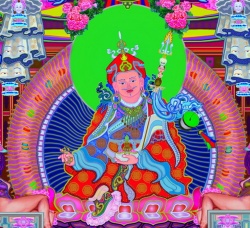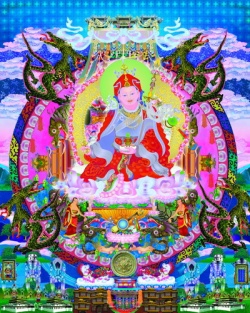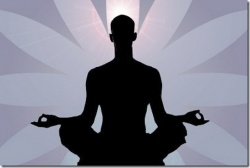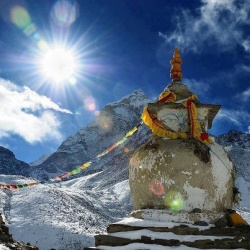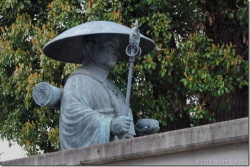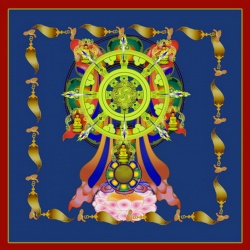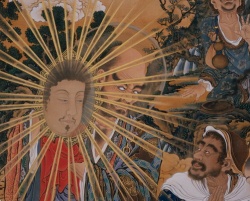The Three Words that Hit the Vital Point
The following is from an oral commentary on the Trekcho teaching "The Three Words that Hit the Vital Point" given by Khenpo Sonam Tobgyal Rinpoche.
THE ROOT TEXT
Homage to the guru.
The view is Longchen Rabjam (Infinite Great Expanse)
The meditation is Khyentse Oser (light rays of Knowledge and Love)
The action is Gyalwai Nyugu (Son of the Victorious Ones)
For the one who practices in this way,
There is no doubt about enlightenment in one lifetime.
But even if not, there is still happiness - a la la.
The view, Longchen Rabjam, is as follows:
To hit the vital point with the three lines,
First, let your mind rest loosely.
Without projecting, without concentrating - without thoughts.
While relaxed and remaining evenly in that state
Suddenly exclaim a mind shattering PHAT!
Forceful, short and sharp - emaho!
Nothing whatsoever - totally blank.
A blankness which is utterly open.
A total openness which is indescribable.
Recognize this as the Dharmakaya awareness.
TO RECOGNIZE YOUR NATURE; THAT IS THE FIRST VITAL POINT.
After this, whether you are thinking or still,
Whether you are angry, or attached, happy or sad,
At all time and on all occasions
Acknowledge the recognized Dharmakaya (this is our basic awareness)
And let the child luminosity unite with the already known mother.
Rest in the state of inexpressible awareness.
Destroy again and again stillness, bliss, clarity and thinking.
Let the syllable of knowledge and means suddenly strike down.
No difference between meditation and post meditation.
No division between sessions and breaks.
Rest continuously in the undivided state.
However, as long as you have not attained stability,
It is essential to give up distractions.
Divide your meditation into sessions.
At all times and in all situations
Maintain the single continuity of Dharmakaya ( basic presence of awareness)
Resolve that there is nothing other than this.
TO DECIDE ON ONE THING; THAT IS THE SECOND VITAL POINT.
At this time, your likes and dislikes, joys and sorrows
And all your passing thoughts without exception
Leave no trace in the state of recognition.
By recognizing Dharmakaya (basic awareness) in what is liberated,
As in the analogy of drawing on water,
There is unceasing self-occurring self-liberation.
Whatever occurs is fresh food for the empty awareness.
Whatever is thought is an expression of the Dharmakaya king.
Traceless and naturally free - a la la.
The way thoughts occur is the same as before,
But the way they are freed is the most essential key point.
Without this, meditation is but the path of confusion.
Possessing it is the uncultivated state of Dharmakaya (awareness)
TO GAIN CONFIDENCE IN LIBERATION; THAT IS THE THIRD VITAL POINT.
This view endowed with three vital points
And the meditation of combined knowledge and compassion,
Is aided by the general actions of the sons of the victorious ones. Even if the victorious ones of the three times were to confer together, They would have no oral instruction superior to this.
The Dharmakaya treasure revealer of awareness-display
Discovered this as a treasure from the expanse of knowledge.
It is unlike extracts of earth and stone.
It is the testament of Garab Dorje.
It is the heart of the three lineages.
It is entrusted with secrecy to heart disciples.
It is the profound meaning and words from the heart.
It is words from the heart, the essential meaning.
Do not let the essential meaning fade away.
Do not let the instruction dissipate.
This was the special teaching of Khepa Shri Gyalpo
Translation by Tulku Thondrop and Tulku Pema Wangyal
Tregchöd and thödgal
Once the state of non-dual contemplation has been arrived at, one has to continue in it. This continuation has two levels of practice: tregchöd and thödgal. These are main practices presented in the Menngagde series (Oral Instruction Series) of the dzogchen teachings.
http://en.wikipedia.org/wiki/Dzogchen#Tregch.C3.B6d_and_th.C3.B6dgal
The following quotes are from the commentary on the above root text on the precious inner secret instructions of Dzogchen Trekcho. Secret because without first-hand realization, they make minimal sense.
"The Second Word: Decide On One Thing (the Meditation)
In the last posting we completed the presentation of the first of the Three Words, which is the recognition within oneself of the innate wisdom that is the fundamental nature of one's mind and the ground of all experience. The second point is concerned with the manner in which one can bring this recognition into one's experience, through maintaining it in meditation."
"To begin with, if there has been no recognition of the innate wisdom, then there is nothing to meditate upon. There is no way to go further. That recognition must occur first. But once one has recognized the innate wisdom, the next concern is the cultivation of a meditation that is continuous and unbroken like the flow of a river, a meditation that consists of simply allowing the mind to rest naturally within that which has been recognized, and maintaining such a meditation in all situations and at all times. If one does not waver from this recognition, then it makes no difference what else is going on in one's mind."
"Therefore, other than resting within this recognition of the innate wisdom, there is no fabrication, change or effort that one needs to make. There is nothing else to do in meditation than simply to maintain that recognition. There is no need to attempt to establish a state of stillness, or to attempt to get rid of the movement of thought within the mind. If the mind rests within the recognition of innate wisdom, then the mind is manifesting as the nature of the Dharmakaya (our true nature), as the nature of that innate wisdom itself."
"If the mind is active, if there is the occurrence of thought within the mind, as long as this recognition is not lost, then whatever thought arises is merely the expression of that wisdom and is experienced as such, as the "magical display" of awareness. Hence, when there is recognition, then it becomes irrelevant whether there is stillness or occurrence in the mind. So therefore, the next line in the root text says, "THEN IT MAKES NO DIFFERENCE WHETHER THERE IS OCCURRENCE OF THOUGHT OR STILLNESS."
With regard to the occurrence of thought within the mind, examples of such thoughts are kleshas, such as aversion towards that which one perceives as threatening, or attachment towards that which one perceives as pleasant or as affording some kind of security. One would classify such thoughts as pertaining to the Second Noble Truth, the truth of the origin of suffering, since kleshas are the origin of suffering."
"Or there could be an experience of some kind of affect that is not itself particularly a klesha, such as delight or misery, happiness or depression, in which case the thoughts pertain to the First Noble truth, the truth of suffering. So, in the midst of recognition, whatever thought arises in one's mind, whether it is suffering or something that would normally cause suffering, if the recognition is not lost, then one sees the suchness, or the nature of these thoughts. One sees that these thoughts have no nature other than the innate wisdom itself."
"In that sense, whatever occurs in the mind, without any exception, is merely the uprising, or the expression of our own innate wisdom. The only issue here is the recognition of this, or the absence of recognition. So therefore, the next line in the root text says, "WHETHER YOU EXPERIENCE AVERSION OR ATTACHMENT, WHETHER YOU ARE EXHILARATED OR DEPRESSED, MAKES NO DIFFERENCE."
Since nothing other than resting in the recognition of innate wisdom is an issue in this practice, the maintainance of the recognition becomes the deciding factor. In other words, even though you may have recognized the view, recognized the innate wisdom, if you cannot maintain this recognition in meditation, then while the nature of thoughts could never pass beyond being the uprising of that innate wisdom, you will not recognize them as such because you are no longer recognizing the innate wisdom."
"Therefore, when you are distracted from this state of recognition, when you become lost in ordinary delusion, bewilderment, or confusion, then thoughts become independent. "Independent" here means unrecognized. At that point, it appears to you as though thoughts have solidity, have independent existence. And once you are without this recognition of thoughts as being merely the uprising of innate wisdom, then thoughts can bind you in Samsara and actually become causes of suffering."
"Thus, in the absence of recognition, your mind and Dharma have temporarily separated and are no longer keeping company. At that point, you are really no different from anyone else, you have no advantage. If you fall from the recognition back into ordinary confusion, then you accumulate karma just like everyone else. At all times and in all circumstances, a practitioner of Dzogchen must never depart from this natural settling into recognition that we refer to as non-meditation. So therefore, the next line in the root text says, "AT ALL TIMES AND IN ALL SITUATIONS....."
"In Dzogchen, we do not resort to separate remedies for separate mental afflictions, because the only issue here is the presence of and absence of recognition. And if there is recognition, then the mental afflictions are seen as being the expression of the nature, and therefore do not themselves pose a problem. Hence, this is called, the "application of one remedy which liberates everything."
"This liberation is complete; there is nothing that could possibly arise within your mind that from this point of view would require any special treatment. In the maintenance of the view that has been identified, in the continuing recognition of the innate wisdom, everything is taken care of. So therefore, the next line in the root text says, "CONTINUALLY RECOGNIZE THE INNATE WISDOM, THE DHARMAKAYA."
"You will notice that there are two things that we are talking about here:
the innate wisdom itself which is always present and has always been present, and the recognition of the innate wisdom which is not always present. This ever-present innate wisdom is the true nature of the mind, and therefore the nature of whatever arises within the mind: whatever thoughts and mental afflictions arise in the mind are not OTHER in nature than the innate wisdom. They cannot pass beyond that. If something is the nature of everything in a certain sphere, then anything that occurs within that sphere must partake of that nature. This innate wisdom, or naked awareness, that is the nature of all thoughts, is called the "ground clear light," or "ground Dharmakaya." It is also called the "mother clear light present as ground." Another rendition of the Tibetan term translated here as "clear light," is "luminosity" or "luminous clarity."
"As long as one does not lose the recollection of the clear light, this recognition of one's innate wisdom, other than resting in this recognition, there is no issue with regard to meditation. No matter what arises in your mind, it is an expression of that innate wisdom. No matter what mental affliction or thought arises, there is no need whatsoever to attempt to alter or control any of it. There is no need to attempt to get rid of anything that arises or to add anything. As long as there is recognition, nothing that arises is a problem in any way. Also, there is no problem with anything not arising; there is nothing missing, and therefore, there is nothing that needs to be added."
"This is an extremely significant point, and it bears repeating; other than maintaining recognition, there is no need to attempt to reject anything that arises in the mind, and there is nothing that could possibly arise that has any special status whatsoever, that deserves any special attention or is considered in any way superior, or to be adopted as somehow special. So therefore, the next line of the text says, "SIMPLY REST IN INEXPRESSIBLE AWARENESS."
"So therefore, it is extremely important to maintain an unimpeded post-meditative awareness. In other words, while meditation has to come first, it is not enough, it has to be expanded into post-meditation. Therefore, the text at this point says, "AT ALL TIMES AND IN ALL SITUATIONS...."
"So one needs to maintain an unobstructed awareness at all times and in all situations. In the same way as in the meditation session, in post-meditation there is nothing to be meditated upon. You do not have to look for anything to be aware of and recognize other than innate awareness itself. The essence of the even placement of this meditation is not being separate from the view of the Dharmakaya, the recognition of innate wisdom. All your actions, all of your experiences, all of your thoughts, are naturally freed without fixation: literally, they become unreckoned. Unreckoned here means that nothing unseats you, nothing gets any special status that takes you away from awareness. In that even, undistracted recognition, whatever happens is of itself evened out or relaxed; nothing has to be done to your experience. Within that recognition you are not attempting to get rid of anything, or to add anything. You are not attempting to restrict your experience, nor are you attempting to introduce something new to it."
"In the same way, if you do not resolve that there is nothing to pursue beyond this unfabricated and natural practice, if you still think there is something more still to be gained from fabrication, then you become lost in a forest of fabrication, attempting to contrive or create an enlightened state. You will never become awakened until you give that up. Therefore, it is very important to resolve the utter primacy of unfabricated awareness. Hence, the next line of the text says, " RESOLVE THAT THERE IS NOTHING BEYOND THIS."
"In other words, whatever arises is nothing other than the display of this fundamental nature.
Because that is the case, it is extremely important to recognize the innate wisdom in what arises, the wisdom that is the basis of liberation. It is important that you let the arising not sway you from this recognition, but rather intensify it in such a situation. Therefore, in the root text it says, "IN THAT SITUATION (MEANING AT THE TIME OF PRACTICE) WHEN ATTACHMENT OR AVERSION, DELIGHT OR MISERY ARISE...."
"This need for recognition is not limited only to the arising of strong afflictions such as strong attachment or aversion. As long as you do not possess this essential point of simultaneous arising and liberation in your meditation, as long as you do not recognize that whatever arises in the mind is the expression of awareness, all the under-currents of thought that arises in your mind, all of the thoughts that are flowing unnoticed beneath your meditative stability, will accumulate samsaric karmas."
"If you are resting in a state of meditation, and you do not experience thoughts, but there is still an undercurrent of thought that is flowing through but does not particularly bother you, you are still accumulating karma, that thought, those thoughts, are not being revealed and recognized. All thoughts, whether coarse or very subtle, a mere undercurrent, have to be recognized and liberated as they arise, through this essential point of experiencing them as the expression of awareness, even if they do not plainly distract you from that recognition of awareness. Therefore, the root text says at this point, "ALL SUDDEN THOUGHTS, WITHOUT EXCEPTION, MUST BE RECOGNIZED...."
The key point of recognition is that there is a liberation simultaneous with the arising of the thought, which means it leaves no trace. This is explained in the commentary as follows, "Whatever thought arises, and especially the undercurrent of thought that is constantly going on, that does not manifest into full consciousness, that does not become loud enough to really disturb us, has to be recognized and liberated."
"This undercurrent of thought is like water that is flowing through high grass growing in a field. The water may be flowing around the bottom of the grass but you will not see it: if you go by the field, it will look like a dry field of grass but actually it is full of water. Something similar is happening in your mind all the time, and as long as that is not exposed and liberated, the undercurrent still constitutes a vague kind of confusion that adulterates the meditation."
"So that has to be recognized, and recognition means that there has to be a liberation of the thought as it arises. As long as you are not distracted from this recognition, whatever arises in the mind is directly seen, even at the moment of its arising, as nothing other than the display of innate awareness. Therefore, even as it arises, thought is liberated. Liberation upon arising means that thought leaves no trace. It does not produce karma, it does not lead to any further thought, it does not leave a trace in the mind."
"For this liberation to occur, there has to be present what is called a "natural mindfulness." If you have recognized the innate wisdom and are resting in that recognition, then there is a natural mindfulness present in the mind that will reveal and recognize the nature of whatever arises in the mind, including the undercurrent. This is not a heavy handed, intentional mindfulness, as though you were holding some kind of hook that you use to try to pull thoughts up from the undercurrent into the field of easy recognition. It is a mindfulness that is naturally present, based on your being settled in the recognition of the nature of innate awareness."
"It is necessary to recognize whatever thought arises and not just to recognize its arising but also to recognize its nature. What will happen then is that thoughts will be liberated upon arising; they will not leave any trace. The analogy for this in the text is "LIKE A DESIGN DRAWN ON WATER." Even as the design is being drawn, it already vanishes; it does not persist, it does not in any way change the water, or leave a trace in it. That is what needs to happen with all thoughts, including the undercurrent. Therefore, the root text says at this point, "WITHIN RECOGNITION NO TRACE IS LEFT."
"With regard to that recognition of thought, to repeat, it means more than simply recognizing the arising of a thought (or smell, or tastes, or sound, or sight, or feeling, or sensation) it means the self-liberation of the thought. Merely to recognize the presence or arising of a thought (or sound, or sight or....etc) does not sever the production of karma by that thought; however, the self-liberation of that thought does. Self-liberation means that at the very moment at which the thought is recognized, one sees the face of one's own awareness. Just as the arising of the thought did not distract you from the recognition of the innate nature, the recognition of the thought must also not distract you from the recognition of the nature."
"Because there is a direct, totally unfiltered recognition of awareness in the midst of the recognition of the thought, you continue to recognize the innate wisdom that you have been recognizing all along. You remain in that state, resting in the state of recognition, and therefore, thought vanishes without a trace. In this case, recognition means that neither the thought nor the awareness of the thought distracts you from the recognition of awareness itself. And that, the text says, is a very important point about the liberation of thought.
‘To drive home this essential point, neither the thought nor the recognition of the thought, and the recognition of its nature, distracts you from recognition of the innate awareness, and as a consequence, thought vanishes without a trace. The mere recognition of it will not do that. Because of that, the text says at this point, "RECOGNIZE THE DHARMAKAYA, WHICH IS THE SOURCE OF LIBERATION."’
"Again, recognition of thought here means recognizing the nature, not just recognizing the presence of thought. This causes the thought to vanish like a design drawn on water; as the thought is arising, it already vanishes. It is experienced as having no duration and no aftereffect. Just as for a design drawn on water there is the simultaneous appearance and dissolution of the design, so with thought there is a simultaneous occurrence of arising and liberation."
"Self-liberation means that just as thought arises of itself, it liberates by itself. You do not intentionally generate a thought, and you do not intentionally get rid of it, it is self-arisen and self-liberated. Because you are not distracted from the recognition of the innate awareness, the thought is self-liberated as it arises. As long as you rest in the innate awareness, this self-arising and self-liberating quality of thought is unbroken and continuous. Because of the fact that the arising and self-liberation are simultaneous, the text says at this point, "FOR EXAMPLE, IT IS LIKE A DESIGN DRAWN ON WATER."
"From this it also follows that you in no way attempt to prevent thoughts from arising. Whatever for the thought takes, whether it is normally what you would consider a good thought or an unpleasant thought, makes no difference. Because you never waver from the recognition of the innate nature, which includes the nature of thought, whatever thought arises is liberated by being recognized as an expression of this nature. This must be held as a very important part of meditation practice. So therefore, the text at this point says, "THERE IS AN UNCEASING CONTINUITY OF SELF-ARISING AND SELF-LIBERATION OF THOUGHT."
"When one uses thoughts in this way to train in the recognition of the Dharmakaya, of innate awareness, whatever thought arises becomes an opportunity to train in the recognition of this awareness. When thoughts are self-liberated like this, not only do they not pose a problem, they actually become an opportunity for enhancement. When the arising of a thought is seen as an arising of awareness, when thought is recognized as being of the fundamental nature of that innate awareness, then the coarser and more outrageous a thought is, the more clarity and sharpness of awareness it actually brings up."
"Since there has been no separation of awareness and occurrence in the mind, no matter how intense a thought is, the recognizing and liberating awareness that occurs simultaneous with it will be equally intense. Because of that, the root text says next, "WHATEVER THOUGHT ARISES IN THE MIND IS FOOD FOR NAKED AWARENESS AND EMPTINESS."
"This brings up a crucial point that distinguishes Dzogchen meditation from other approaches. In most approaches to meditation, one is told either that one has to get thoughts to stop altogether, or at least one has to ameliorate their content. Some thoughts are alright and other thoughts are not; one has to try to clean them up a bit. But in Dzogchen, we view thoughts as a source of great help in our meditation practice. Because as long as there is sufficient stability of recognition, all that thoughts do is to bring out further clarity of awareness. Even the most outrageous thought, such as fierce anger or intense desire or pride, whatever arises in the mind, is only fuel that will cause one's awareness to be even clearer."
"Because one maintains this impartiality in the recognition of the nature of thought, all thoughts are liberated as they arise. Because of that, nothing that arises in the mind is experienced as other than the expression of Dharmakaya, of innate awareness. So therefore, the root text says, "WHATEVER OCCURS IN THE MIND IS THE DISPLAY OF THE ROYAL DHARMAKAYA."
"When thoughts are experienced in this way, then the conceptuality of mind, which is nothing other than ignorance, and all of the various forms which that ignorance can take, is purified into the expanse of wisdom awareness of the Dharmakaya. In being recognized as never having a nature other than that, thoughts do not leave traces, and thus do not manifest true impurity; therefore, they are purified.
As long as this recognition is maintained, this purification is unceasing. It is not better at some times and worse at other times, or present at some times and absent at other times. As long as the fundamental recognition of innate awareness is maintained, whatever thought arises in the mind is in its essence empty and is experienced as the expression of that emptiness. So therefore, the root text says, "THOUGHTS ARE PURIFIED BY THEMSELVES AND LEAVE NO TRACE. HOW WONDERFUL!"
"The word for "becoming accustomed to something" in Tibetan is etymologically closely related to the word for meditation, and there is a saying in the Dzogchen tradition, "There is nothing to meditate upon, but there is a process of getting used to it." So when you become accustomed to this approach to thought, then thought itself arises as meditation, and you finally heal the split between stillness and occurrence in the mind."
"In this practice, there is no preference with regard to whether the mind has thoughts or does not have thoughts. Even when thoughts arise, they in no way impede your stillness, the stillness of course being the stillness of recognition. The arising of thoughts in no way harms your meditation anymore. So therefore, the text says,
"THE WAY THOUGHTS ARISE IS JUST AS BEFORE."
"When you are accustomed to this practice, that does not mean that thoughts will not arise. In fact, apart from their being recognized as the display of innate awareness, the variety of thoughts that arise, for example, as delight or displeasure, hope or fear, is exactly like the way thoughts arise for anyone else, for an untrained person. The difference is explained in the next line of the text: an ordinary person gets caught by thought, clings to thought, reacts to thought with a heavy-handedness, a solidification, that consists of trying to hold onto thoughts and states of mind that are perceived as pleasant and as creating security, and attempting to get rid of, or being frightened by, thoughts and state of mind that are perceived as unpleasant or as threatening."
"Because of this reaction to thought, the ordinary person accumulates karma and comes under the power of his or her attachment and aversion. Of course, the whole process of Samsara rests on that. In this practice, thoughts naturally arise, and the variety of thoughts that arise is the same, but since for the practitioner these thoughts are liberated simultaneously with their arising, they do not accumulate karma. Thus, the difference between the practitioner and the untrained person in not in the arising or non-arising of thoughts, but in whether thoughts are fixated on or liberated."
